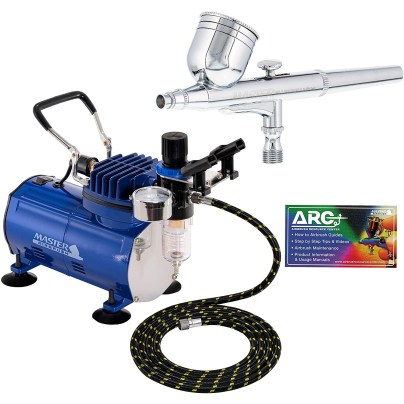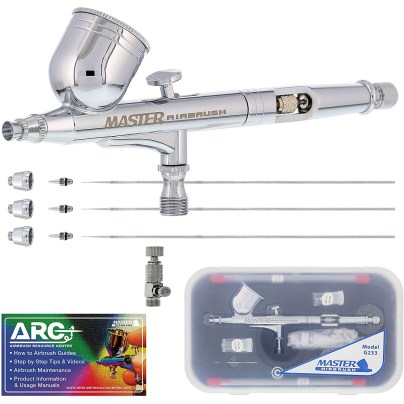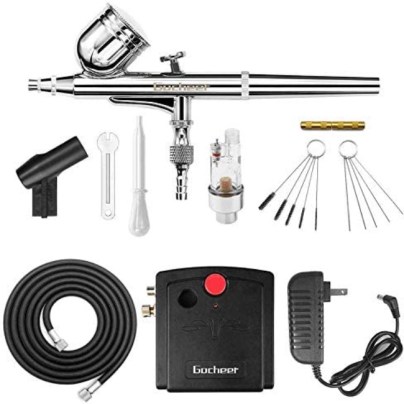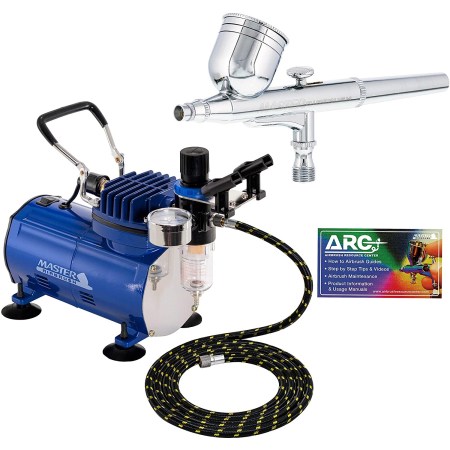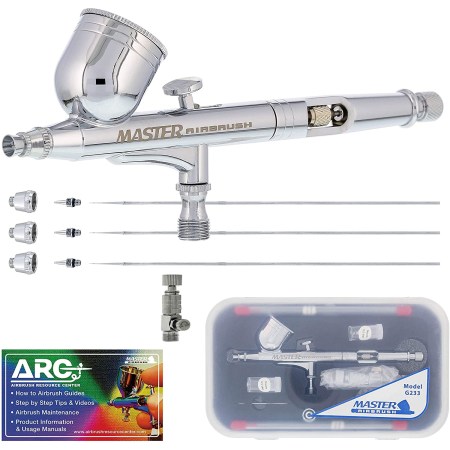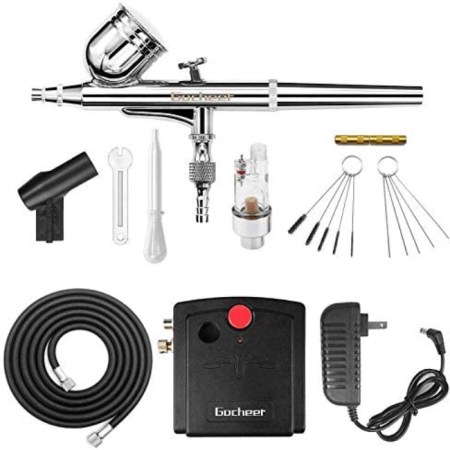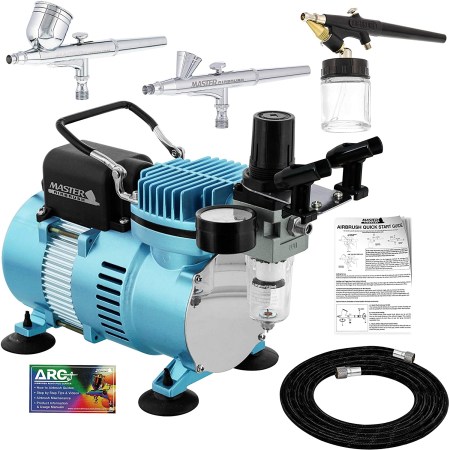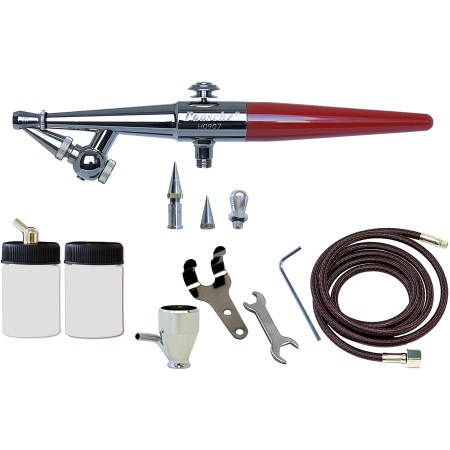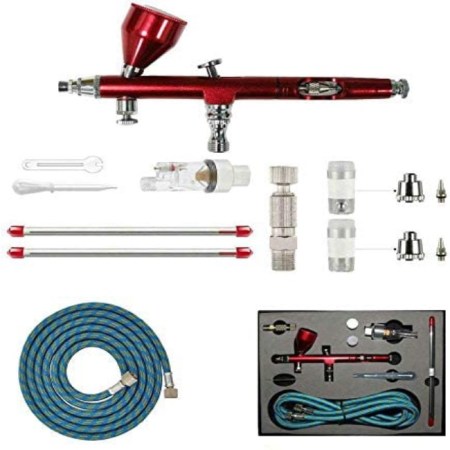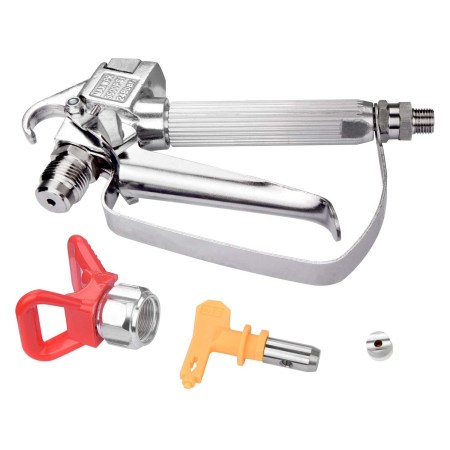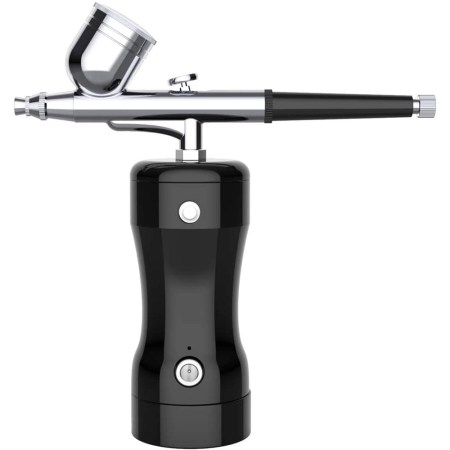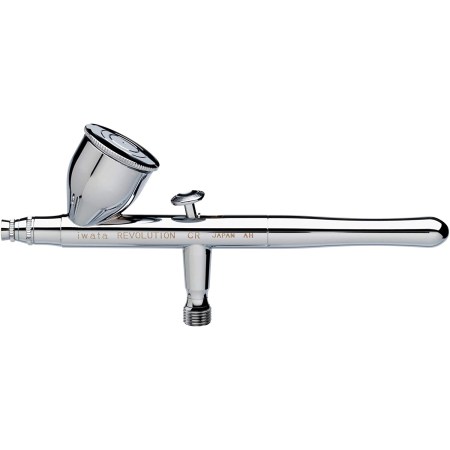We may earn revenue from the products available on this page and participate in affiliate programs. Learn More ›
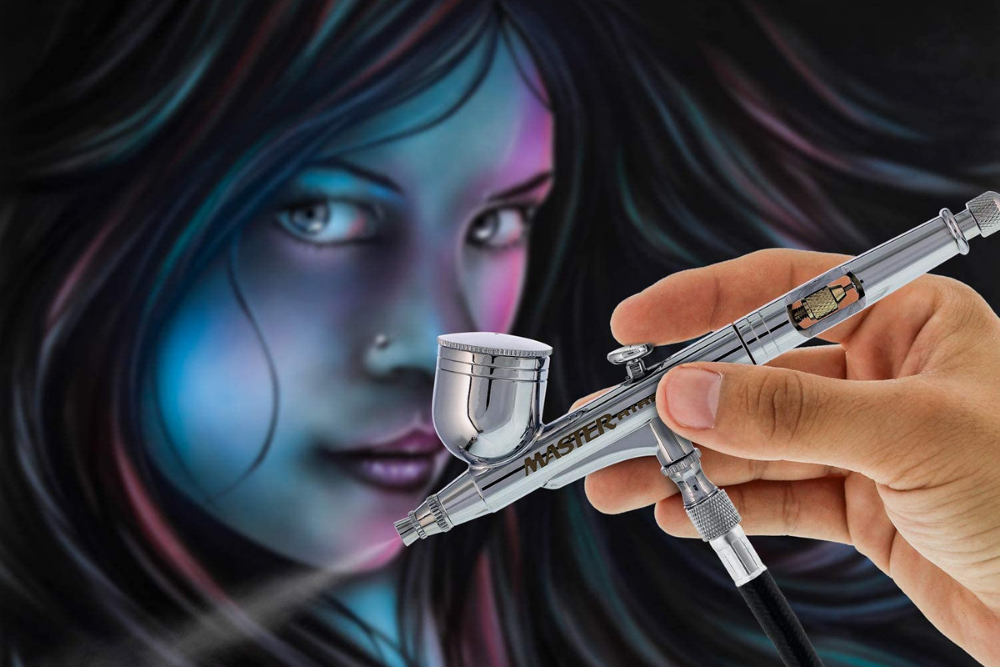
If you’re into painting detailed creations, it might be time to add a high-quality airbrush to your tool kit. Unlike paint sprayers or airless sprayers, this is an air-operated tool that can spray super-fine paint particles. Suitable for use on multiple types of surfaces, an airbrush allows you the flexibility to change an item’s color or to craft a unique, detailed design. Airbrushes are used for everything from nail art to furniture to cake decorating.
Finding the best airbrush can be challenging, as there are more brands making these tools than ever before. The collection of recommendations ahead can help make your decision a little easier.
- BEST OVERALL: Master Airbrush Gravity Feed Dual-Action Airbrush Kit
- BEST BANG FOR THE BUCK: Master Airbrush Master Performance G233 Pro Set
- BEST FOR BEGINNERS: Gocheer Mini Airbrush Kit
- BEST FOR ADVANCED USERS: Master Airbrush Cool Runner II Airbrushing System
- BEST SINGLE ACTION: Paasche Airbrush H-Set Single Action Airbrush Set
- BEST DUAL ACTION: HUBEST New Professional Dual Action Airbrush Kit
- BEST PISTOL GRIP: DUSICHIN DUS-036 Airless Paint Spray Gun
- BEST FOR MINIATURES: YLINGSU Cordless Airbrush
- BEST FOR LARGE AREAS: Iwata-Medea Revolution CR Dual Action Airbrush
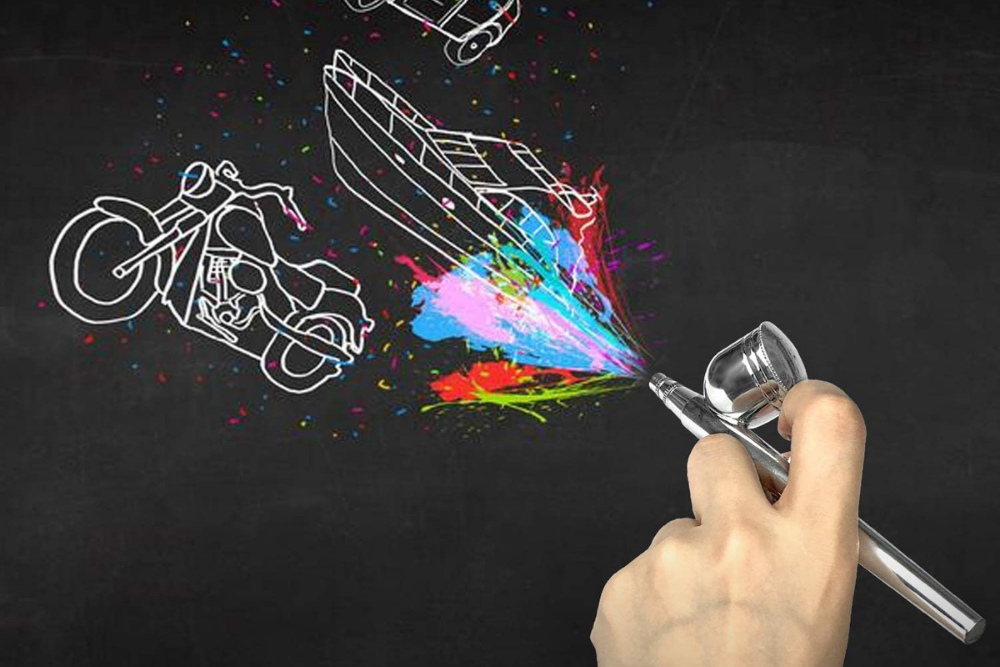
Types of Airbrushes
There are four common types of airbrushes, and each can be used for a range of projects. Whether you are an artist or DIYer, learning about the pros and cons of each type can help you find the best airbrush for your needs.
Single Action
A single-action airbrush can only be pressed down and can’t move in any other direction. While you can’t move the trigger around, you can still control the amount of paint that the brush releases. You just have to adjust the nozzle size to your desired setting before painting.
Single-action airbrushes are appropriate for beginners because they are the most affordable and the simplest to use. The tool’s trigger feels very similar to the top of an aerosol spray paint can. While they work well, they’re not suited for projects requiring a lot of detail or the ability to control the paint’s flow. Single-action airbrushes work well for painting furniture, detailing cars, or crafting larger designs on bigger surfaces.
Dual Action
Without a doubt, the dual-action airbrush is the most popular type for both professionals and enthusiasts. Also referred to as a dual independent control brush, this model’s trigger allows you to manage the paint volume and airflow precisely. Pushing the trigger down releases the air, and pulling the trigger backward releases the paint. The farther back you pull the trigger, the more paint flows out.
Because these tools are a more advanced type of airbrush, it takes some practice. However, most users find they love how the tool gives them the ability to customize and control the paint. That capability makes dual-action airbrushes ideal for applying makeup, temporary tattoos, or painting miniatures.
Automatic
If you’re spending a lot of time airbrushing or have a particularly large surface to paint, you might find constantly pushing down on the trigger to be uncomfortable. If so, an automatic airbrush might be a better fit. Automatic-style airbrushes are typically used for painting cars, murals, building exteriors, and other large projects that require a lot of time to complete.
Instead of requiring the user to push down on a trigger to release the air, the automatic model, also known as a double-dependent control model, automatically starts airflow when the trigger is pulled back to release the paint. So while you’re not freed from the trigger entirely, you do get the customization of a double-action airbrush without having to manually enact multiple functions simultaneously.
Pistol Grip
Another common, though harder to find, type of airbrush is the pistol grip. Characterized by its pistol-style trigger shape, this model looks more like a spray gun than an aerosol can. When you pull the trigger backward, the valve opens and first releases air then releases paint. The harder you pull the trigger, the more paint is released.
This kind of airbrush is more ergonomically comfortable than others and helps prevent hand strain from long painting sessions. Plus, it’s more comfortable for those with decreased mobility. Many relate a pistol-grip airbrush to a single-action airbrush. However, pistol-grip types tend to be more expensive.
Pistol-grip airbrushes can be used for all sizes and styles of projects; however, they’re typically used for larger projects like customized furniture and building exteriors.
What to Consider When Choosing the Best Airbrush
With many options available on the market, it’s helpful to break down the characteristics of the choices. Everything from tip size and brush material to paint compatibility can affect the kind of airbrush that will work best for your project. Read on to learn about the features you may want to consider before investing in a new airbrush set.
Surface Type and Size
Probably two of the most essential things to consider when choosing an airbrush are the types of surfaces you’ll be painting most often and the size of those surfaces. If they’re bigger jobs like large furniture or cars, you’ll want a brush with a larger nozzle. Smaller jobs with more detail, like painting nails, can be done with a smaller airbrush.
In general, the larger the airbrush, the heavier it will be. You’ll get more power for painting, but the extra power also adds excess weight. How much paint and how long you’ll usually be working also factors into how big an airbrush you need. Smaller tools hold less paint, so they’re lighter, but you’ll have to refill them more frequently.
Material
When it comes to the materials that make up an airbrush, there’s generally only one type available: stainless steel. Luckily, this makes these tools easy to clean and maintain over time.
The type of surface you can airbrush depends entirely on the kind of paint you use. But generally, every airbrush can be used for every project. The surfaces that can be airbrushed include most types of materials, including wood, metal, fabric, plastic, cakes, and skin.
Paint Type
Most airbrush paints will be compatible with any airbrush gun, especially if you’re choosing a model that’s labeled as multipurpose. However, most airbrush kits do not include paints, so you’ll have to purchase those separately and decide which type will work best for your project.
Hobby paint is the most general kind of paint and can be used on plastic, metal, wood, resin, and ceramic. If you’re just starting out, it can be easy to experiment with hobby paint. Other types, like nail art paint, fabric paint, automotive airbrush paint, and temporary tattoo ink, require more skill and precision.
Feed Type
An airbrush’s type of feed is the mechanism that feeds the paint into the body of the airbrush. There are three common types of feeds found in today’s models: side feed, gravity feed, and siphon feed.
Siphon feeds use fast-moving air to generate a low-pressure zone at the tip of the nozzle that pulls the paint up through the airbrush’s stem where it becomes atomized. While they require more air, they also hold more paint. On the other hand, gravity feeds pulls the paint down to the nozzle tip using—you guessed it—gravity. They use less air and can spray small, finer details than airbrushes with other feeds.
The side feed is a cross between the siphon and the gravity feed. It pulls air using both directions, depending on how much paint is in the brush. Because they operate on lower pressure settings, gravity-feed airbrushes are better reserved for projects with fine lines and details. Siphon feeds are better for large projects, as they can hold more paint. Side-feed airbrushes usually come with a lot of attachments and are very adaptable, which can be a plus for artists who are constantly switching up the size and detail of their projects.
Internal vs. External Mix
Whether you choose an airbrush with an internal or external mix depends on how you want the paint to look when it sprays onto the surface you’re painting. This refers to the way the air stream and the paint mix within the tool.
Internal mix means that the paint is hit and released in the center of the airstream. External mix means that the paint is hit and released through the side of the airstream. When that happens, a D-shaped pattern is produced on the surface. Internal mix is best suited for projects that require small areas, while external mix is better for larger areas that don’t require a ton of detail work.
Tip Sizes
When choosing the best airbrush for your project, tip size should be taken into consideration. Generally speaking, the larger the tip size, the thicker the amount of paint that is released. Most airbrush nozzles fall within 0.2 to 0.7 millimeters, and a common multiuse tip size is in the middle at 0.5 millimeters. However, if you’re working on a project that requires more refined details, like a miniature toy or collector’s item, look for a tip under 0.5 millimeters.
The best airbrush sets usually come with multiple tips to give you more flexibility for your projects. If your airbrush doesn’t come with these, you can buy a set of multiple tips separately.
Air Compressor
The best home air compressors provide the airflow necessary to release the paint in your airbrush and determines how you regulate the air pressure as you paint. Some kits come with air compressors, and others require you to purchase one separately. You’ll want to choose your compressor based on how much noise you can tolerate, how much electrical power it needs, how much tank capacity you wish to have, and how much money you’re willing to spend.
No matter what size compressor you choose, it is helpful when it comes with a filter to prevent condensation from getting inside the tank. This is especially crucial if you live in an area with a naturally humid climate. It’s also good to find one with a pressure regulator, so you can ensure and control optimum air output.
Accessories
Today’s airbrush kits come with additional features that can make your DIY time more enjoyable, such as an auto-off function that shuts down the air compressor when it’s not in use. Another common accessory is a moisture trap. While it’s not essential, it can help reduce moisture and lead to fewer defects in your paint layers. Some kits will also come with manuals and guides that can teach you how to airbrush, which could be helpful for beginners. Other accessories include cleaning stations, extra paint, stencils, holders, and workstations.
That being said, additional accessories and features tend to increase the cost of the kit, so it’s important to think about which ones you’ll actually need and use.
Our Top Picks
Once you’ve got your preferred type of airbrush in mind and a good idea of what factors would be the most beneficial to you and your home improvement projects, it’s time to start shopping. Keep reading for a selection of some of the best airbrush kits available.
Best Overall
Master Airbrush Gravity Feed Dual-Action Airbrush Kit
See ItIf you’re looking for an airbrush that seemingly has it all, look no further than the Master Airbrush Gravity Feed Dual-Action Airbrush system. The Model G22 airbrush can be used for a variety of projects, thanks to its 0.3-millimeter fluid tip set and .33-ounce gravity fluid cup. Included is the Model TC-20 High Performance ⅕-horsepower compressor, which is one of the quietest compressors on the market and features an air filter water trap to prevent condensation within the brush. The set also comes with a 6-foot air hose and mount to hold the airbrush in one place while you work.
Its gravity feed makes this dual-action airbrush a great tool for beginners and professionals alike. However, this kit is more expensive than other models and doesn’t include multiple tips.
Best Bang For The Product
Master Airbrush Master Performance G233 Pro Set
See ItGet professional-grade airbrushing without the price with the Master Airbrush Master Performance G233 Pro Set. This kit comes with three tip sizes—0.2 millimeters, 0.3 millimeters, and 0.5 millimeters—so you have the flexibility to work on multiple types of projects. The dual-action gravity feed comes with an ergonomically designed trigger to help you easily adjust and control the paint flow as you go. It also comes with an airbrush quick-disconnect coupler and a plug with a built-in airflow control valve.
Even though this user-friendly tool is easily one of the most affordable airbrushes on the market, the kit doesn’t come with an air compressor. Before purchasing a compressor, check with the manufacturer to make sure it’s compatible with this model.
Best For Beginners
Gocheer Mini Airbrush Kit
See ItAirbrushing can be an intimidating hobby for those who are trying it for the first time. The Gocheer Mini Airbrush Kit makes it easier than ever to learn thanks to its small size and simple-to-use instructions. This gravity-feed airbrush comes with a 0.3-millimeter tip suitable for most projects and a dual-action trigger that allows you to change the width of the paint line. It also lets you change the range of value and paint opacity without constantly turning the machine on and off.
Plus, the included mini air compressor makes this kit easy to transport and store. The only downsides are that it doesn’t come with multiple tips, and the compressor can only be used for up to 30 minutes. After that limit, it needs time to cool off.
Best For Advanced Users
Master Airbrush Cool Runner II Airbrushing System
See ItWhether you want to improve your airbrushing technique at home or use this tool for work, investing in a high-quality set like the Master Airbrush Cool Runner II System can take your skills to the next level. With three professional airbrushes included, you’ll be able to try out multiple types, such as the single-action siphon feed and the dual-action gravity feed.
The single-piston compressor has two cooling fans, so you can run them for longer periods without having to take cool-down breaks. The compressor also comes with two holders for your airbrushes, as well as a carry handle, water trap filter, and pressure regulator. With these features, this airbrush set is one of the more expensive options available.
Best Single Action
Paasche Airbrush H-Set Single Action Airbrush Set
See ItSingle-action airbrushes are excellent options for quick and easy spraying. The Paasche Airbrush H-Set Single Action Airbrush Set has three head sizes: 0.45 millimeters, 0.65 millimeters, and 1.05 millimeters, which gives you a wide range of painting options and applications. Using a siphon feed, this chrome-plated model achieves paint patterns between .0625 inches and 1.5 inches thick. While it may be a basic airbrush, this set also includes multiple spray heads, a storage bottle, a 6-foot braided air hose, a hanger, a wrench, and a starter’s manual. Since single-action airbrushes require less practice than double-action models, this model is a great option for beginners.
Best Dual Action
HUBEST New Professional Dual Action Airbrush Kit
See ItAffordably priced and easy to operate, the HUBEST Airbrush Kit is a great dual-action tool. Thanks to its micro air control valve, you can adjust the airflow at the head of the airbrush and thus control exactly how much paint is released. Its gravity-feed requires less air pressure and allows for slower hand movements, enabling you to better handle those fine-detailed projects.
This kit comes with three nozzle sizes—0.2 millimeters, 0.3 millimeters, and 0.5 millimeters—as well as an air hose, mini-filter, quick coupler, and nozzle wrench. The drawback is that it doesn’t come with an air compressor.
Best Pistol Grip
DUSICHIN DUS-036 Airless Paint Spray Gun
See ItPeople who find traditional airbrushes to be a little uncomfortable might want to try a pistol-style airbrush, like the DUSICHIN DUS-036 Airless Paint Spray Gun. With fine atomization and high efficiency, this tool comes with a universal tip guard, a forged gun head, and a four-finger trigger that can be activated with just a soft pull. Plus, its non-slip handle makes this airless sprayer even more comfortable to use.
This tool is made with stainless steel, making it durable and resistant to rust. While this is a great option for larger projects, like painting your home’s exterior or bigger pieces of furniture, it probably isn’t the best tool for detail work.
Best For Miniatures
YLINGSU Cordless Airbrush
See ItWorking with miniatures just got easier thanks to the YLINGSU Cordless Handheld Airbrush Gun. This handheld device can be used from 30 to 50 minutes after a single charge from its USB charging cable. And because of its integrated structure, this single-action airbrush can be used without a hose.
In addition, this portable airbrush comes with an equally portable air pump that is ergonomically designed for handheld comfort and easy operation. The YLINGSU Cordless Handheld Airbrush Gun is great for miniatures as well as makeup, cake decorating, and even temporary tattoos. Because of its small size, it’s easy to hold for long painting sessions. However, it’s not an ideal tool for larger surfaces.
Best For Large Areas
Iwata-Medea Revolution CR Dual Action Airbrush
See ItLarge surfaces don’t stand a chance with the Iwata-Medea Revolution CR Dual Action in your tool kit. With an internal mix and a dual-action top-feed design, this airbrush comes with a larger nozzle, cup, and 0.5-millimeter tip to help you spray thicker and heavier paints while also covering a bigger area. Its redesigned triggered mechanism and ergonomic handle make it more comfortable to hold for long periods.
The Iwata-Medea Revolution model is easy to assemble and comes with a replaceable, internal solvent-proof needle. While it works well for big surfaces, it should not be used on smaller areas that require more fine-tuning.
Tips for Using an Airbrush
Using an airbrush properly is a skill that requires time and patience. Below are a few tips to help you achieve the best quality from your airbrush and ensure that it lasts a long time.
- Before you get started playing with your new tool, it’s important to pay careful attention to how you use the needle. The needles can be easily bent. A bent needle is a common occurrence and usually requires a replacement.
- Use the airbrush holder, if included, as it can make both filling the brush with paint and cleaning it much easier.
- Before spraying paint, some experts suggest filling the tool with a little paint thinner so that the internal components, such as the needle and the nozzle, are not dry before they are exposed to the paint.
FAQs About Airbrushes
Now that you’ve learned about the features and differences among some of the best airbrushes, you may have some additional questions. Keep reading to find more helpful information about top-quality airbrushes and how to choose the right one for your next big project.
Q. How does an airbrush work?
An airbrush works by passing compressed air through a venturi that suctions paint from an interconnected reservoir, which is then released from the gun as a spray.
Q. What are airbrushes for?
Airbrushes are used for things like painting furniture, homes, art, miniatures, nails, applying makeup, cake decorating, and even putting on temporary tattoos.
Q. How do you use an airbrush?
It depends on which type you have, but after most airbrushes are connected to an air compressor, you push down the trigger to release the air and the paint.
Q. Can you use airbrushes without a compressor?
No. You need pressurized air to operate an airbrush.
Q. How do you clean an airbrush?
Disassemble the entire tool and soak the needle cap, nozzle, and nozzle cap in rubbing alcohol, and then wipe the needle clean with rubbing alcohol.
